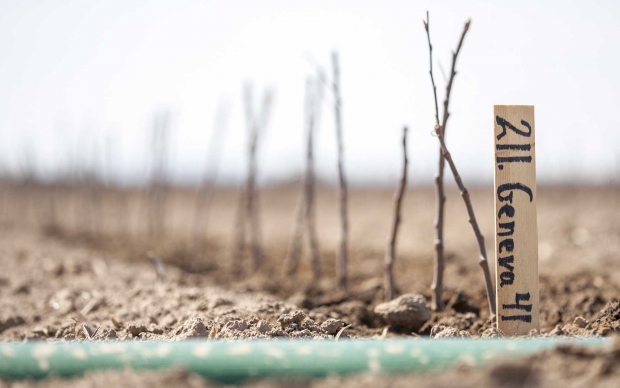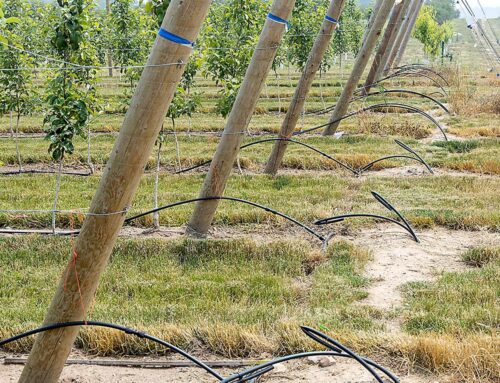
Geneva 41 stool beds at Willow Drive Nursery in Ephrata, Washington, on May 1, 2014.(TJ Mullinax/Good Fruit Grower)
The fire blight-resistant Geneva 11 and 41 apple rootstocks are in big demand, Washington State nurseries report.
That’s driven in part by an industry shift toward new varieties, such as Jazz, Envy, Pink Lady, or Gala, that are more susceptible to fire blight than traditional, low-vigor varieties like Red Delicious.
Both rootstocks are tolerant of crown rot and highly resistant to woolly apple aphids.
And, G.41 is also tolerant of replant disease.
“That’s probably been as big of an interest for Washington growers as the fire blight resistance,” said Neal Manly, chief marketing officer at Willow Drive Nursery, Ephrata. “It’s going to become even more important as we start having issues with availability of fumigants.”
Willow Drive is a licensed propagator of the Geneva rootstocks and not only uses them for its own nursery trees but supplies other nurseries.
Manly said Willow Drive, which has customers throughout the United States and Canada, has not been able to keep up with demand for the G.11 and G.41 rootstocks, despite having ramped up production fairly quickly. It is also propagating some of the newer rootstocks, such as G.935.
G.11 and G.41 are close to M.9 in size in Washington. G.935 is larger, more like M.26, and is very resistant to fire blight and tolerant of replant disease.
Manly said they have pretty good numbers of Geneva rootstocks in their stool beds. “But there’s always that unknown about which one is the grower going to settle on and is the best for their purposes. You hate to commit to any one before the dust settles.”
Large rootstocks
Willow Drive has a small amount of G.969 material, which recently came out of tissue culture. There’s been no pent-up demand, since it is reputed to be a large rootstock, reports Richard Adams, who is in charge of stool bed production at Willow Drive.
“Some say it’s a large 26 and some say it’s a 7, so it’s a large one, and there’s really not a high demand for those larger roots right now.”
Though a weak variety like Honeycrisp benefits from a relatively vigorous rootstock, he thinks there are much better choices for Honeycrisp, such as G.935.
Adams, who earned a master’s degree at Cornell University, Geneva, where the rootstocks were developed, said information he’s received from Geneva suggests that G.969 will find specific niches and is being eyed by cider apple growers in the eastern United States who want a large, free-standing tree. “It’s kind of built for the cider industry,” he said.
The nursery has a small amount of G.210, another large rootstock similar to M.7 in size. The rootstock is still so new that demand is difficult to gauge.
“That being said, I think 210 has a possibility of being a good one, because it’s probably the most replant resistant of all of the Geneva rootstocks,” Adams added. “So I could see it taking off, but I think right now it’s a little early to say.”
Willow Drive is growing small quantities of G.890, which could be even more vigorous—possibly in the M.7 to MM.106 size range. Adams said it has a nice package of features, including fire blight resistance and tolerance to replant disease, woolly apple aphids, and crown and root rots, but might just be too large.
Longer wait
Paul Tvergyak, marketing director at Cameron Nursery, Eltopia, Washington, which is also licensed to propagate Geneva rootstocks, said demand is strong for G.11 and G.41, but supplies are more limited than for some other dwarfing rootstocks, such as Malling 9, and growers face a longer wait for nursery trees.
Tolerance to replant disease is one of the appeals of G.41, but that doesn’t mean the grower can skip fumigation, he said. If a grower is spending many thousands of dollars per acre to replant a high-density orchard with new trellis systems and irrigation, etc., the cost of fumigation is relatively small.
“I think you’d be ridiculous to not fumigate, regardless of what rootstock you put in,” Tvergyak said. “If you have that much money invested that’s a really big risk.”
Everyone is learning about how to handle the new rootstocks, including the nurseries, he said. First of all, nurseries have to figure out how to grow them, then growers have to learn how they perform in the orchard and how they affect fruit size and production. Many of the rootstocks have only been tested in small plots in the West.
They will need to be planted commercially before growers really know what they’re dealing with, Tvergyak added.
“People expect it’s a widget—you pull if off the shelf, and it does exactly what the research guy says it’s going to do,” he said. “But we have to be patient and work our way through it. It will take time—longer than a lot of folks are thinking.” •






I’m an amateur grower who is grafting almost exclusively onto G-41 and G-202 (some onto G-30) So far so good! In my parts we get everything, including crown rot and fireblight so the G series is greatly appreciated. They are also precocious and produce good sized fruit! I’ve grafted maybe 80 different cultivars onto G-41 and they all seem very happy!